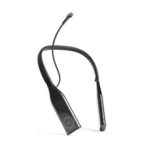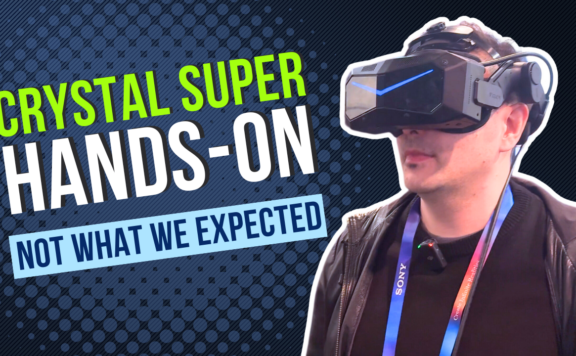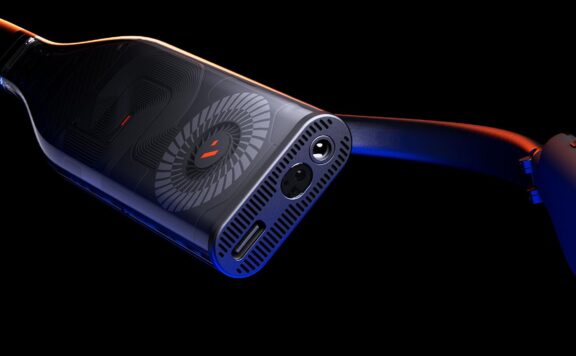The VITURE Pro Neckband is the second neckband-style source device from VITURE. Users wear it around their neck, and it connects to the VITURE glasses via a short cable. While the first-generation neckband did an acceptable job of providing content to the glasses, it failed to fully convince us or consumers. The loud fan, mediocre battery life, and cumbersome controls made for a less-than-ideal experience.
What’s new?
With the Pro Neckband, VITURE aims to address these issues. The device is marketed as quieter, more powerful, and overall superior to its predecessor. It now features an AI companion that can be summoned via voice command, along with a built-in camera for hand-tracking. According to the promotional material, users can control the device with hand gestures, including pinch gestures to adjust screen sizes. Most importantly, the Pro Neckband introduces 3DOF tracking, allowing users to pin the virtual screen in space. This is a significant upgrade, as it enables users to shift their head to view different parts of the display instead of relying solely on their eyes, which can be fatiguing over time. Think of it as having a virtual screen that stays in place, no matter how you move your head. Additionally, there’s a new “smooth follow” mode, where the virtual display follows your gaze more naturally and less abruptly than before.
I received the Pro Neckband in early January 2025, making me one of the first users to test it. VITURE is shipping these in batches to pre-order customers, but unfortunately, I must report that, as of now, the software still feels like a beta release. In my opinion, the company should be more transparent about this.
Spacewalker – VITURE’s Spatial OS
Before diving into the software issues, let’s talk about what runs on the Pro Neckband. It features a heavily modified version of Android with full access to the Google Play Store. VITURE seems to have convinced Google that the device is an Android tablet rather than an Android TV box, which is a much better approach than the Android TV-based source players some competitors offer.
In “Spacewalker” mode, the device operates similarly to XREAL’s Nebula OS, offering a spatial computing environment with multiple virtual screens. You can run Android apps on up to two virtual displays, while a third screen displays all installed apps. This setup works well—you can watch YouTube in the center screen while checking your X timeline on the right. Most importantly, this mode supports 3DOF tracking and smooth follow, which I believe are the key selling points of the Pro Neckband.
In standard Android mode, however, the entire screen moves with your head, just like when connecting the VITURE glasses directly to a phone or tablet. No spatial functions are available in this mode.
Overall, the neckband itself is a good concept, and the hardware looks promising. The fan noise is much quieter this time around, and the device no longer heats up as much as the first version.
I also like the idea of the AI assistant. You can summon it by saying “Hey Vizard!”. You will get a pop up and Vizard will answer one question at a time. In general, that is a pretty good idea and it works well. Unfortunately though it is pretty outdated and uses Open AI’s GPT-3 which was last updated in October 2023. Also, the model will not remember any context, so you cannot get into conversations with it. You can ask one question at a time. But that’s not really a big deal for now.
Simply Not Ready Yet
Let’s talk about the big deals, the basic building blocks that are simply not ready yet and leave a lot to be desired.
So, what’s wrong? First, the 3DOF mode is unstable. When shaking your head, the virtual screen still moves and shakes, making it feel less like it’s truly pinned in space. A firmware update improved this somewhat, but it’s still far less stable than XREAL’s Beam Pro, which is astonishingly steady in 3DOF mode.
Next, let’s talk about controls. Right now, you still need your phone to operate the Pro Neckband. After installing the VITURE app, you can use your phone in air mouse mode or trackpad mode. In air mouse mode, your phone functions like a laser pointer, allowing you to select icons on the virtual screen. In trackpad mode, your phone’s touchscreen acts as a trackpad. Both modes work, but requiring a second device to control the neckband is far from ideal.
The hand-tracking is an absolute disaster. Activating it by long-pressing the settings button reveals a message admitting it’s still in beta. It’s a far cry from what’s advertised on VITURE’s website. Calling it “clunky” would be an understatement—it’s outright bad in its current state. No, you cannot pinch with both hands to resize the screen as shown in the promo material. Instead, you move a virtual hand cursor around the screen and pinch to click. Sometimes it works, but controlling the cursor with your hand feels unnatural, especially since you can also move it with your head. The result is a frustrating, broken experience. This is particularly disappointing given how misleading the promotional material was. If I had paid $300 expecting polished software, I would be extremely unhappy right now.
To make matters worse, DRM-protected content doesn’t work yet. I couldn’t watch Netflix, Disney+, or other streaming services in Spacewalker mode with 3DOF or smooth follow. That was the final straw for my first impressions. VITURE claims this will be fixed in a future update, but as of now, it simply doesn’t work.
These Glasses Deserve Better
Considering the unstable 3DOF tracking, poor hand-tracking, and reliance on a second device for controls, it’s easy to see why I cannot currently recommend the VITURE Pro Neckband—especially at its $299 price point, which is quite steep compared to the glasses themselves.
That said, this is not my final review. I consider this a first impressions preview based on early software, and I will give the Pro Neckband another chance once it officially launches. By then, the hand-tracking had better match the promotional claims.
The VITURE Pro glasses are incredible, and they deserve a much better source device. Hopefully, the VITURE engineers can deliver on their promises!


